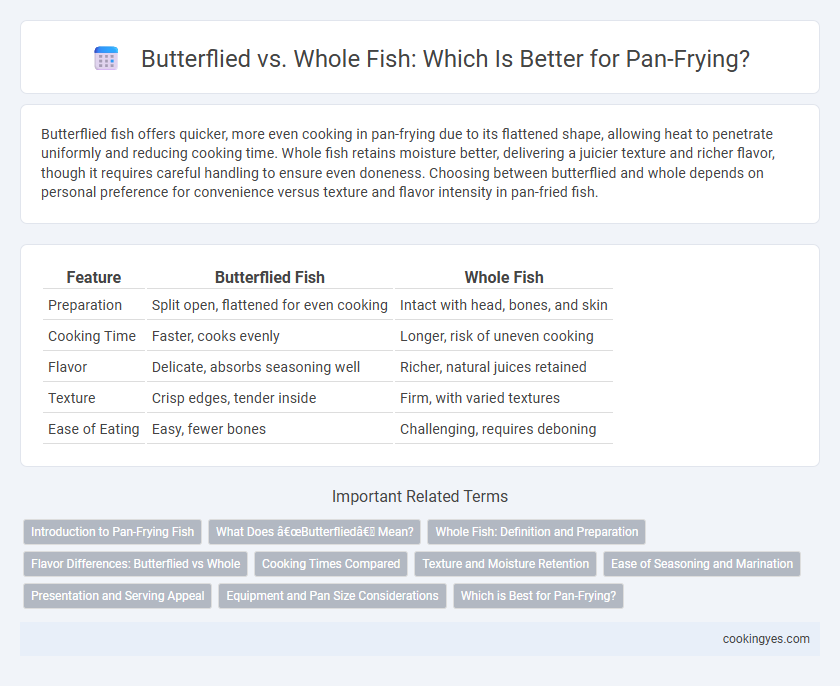Butterflied fish offers quicker, more even cooking in pan-frying due to its flattened shape, allowing heat to penetrate uniformly and reducing cooking time. Whole fish retains moisture better, delivering a juicier texture and richer flavor, though it requires careful handling to ensure even doneness. Choosing between butterflied and whole depends on personal preference for convenience versus texture and flavor intensity in pan-fried fish.
Table of Comparison
| Feature | Butterflied Fish | Whole Fish |
|---|---|---|
| Preparation | Split open, flattened for even cooking | Intact with head, bones, and skin |
| Cooking Time | Faster, cooks evenly | Longer, risk of uneven cooking |
| Flavor | Delicate, absorbs seasoning well | Richer, natural juices retained |
| Texture | Crisp edges, tender inside | Firm, with varied textures |
| Ease of Eating | Easy, fewer bones | Challenging, requires deboning |
Introduction to Pan-Frying Fish
Butterflied fish offers increased surface area for even heat distribution during pan-frying, resulting in crispy edges and faster cooking times. Whole fish retains moisture more effectively, preserving flavor and texture but requires careful scoring to ensure thorough cooking. Selecting between butterflied and whole depends on desired presentation, cooking speed, and flavor intensity in pan-fried dishes.
What Does “Butterflied” Mean?
Butterflied fish refers to a whole fish that has been split open along the backbone and spread flat, creating an even thickness ideal for pan-frying. This technique allows the fish to cook more quickly and evenly compared to whole fish, reducing the risk of undercooked or overcooked sections. Butterflied fish also provides more surface area for seasoning and crisping the skin, enhancing flavor and texture during cooking.
Whole Fish: Definition and Preparation
Whole fish refers to the fish served intact, including the head, bones, and skin, maintaining maximum moisture and flavor during pan-frying. Proper preparation involves scaling, gutting, and scoring the skin to ensure even cooking and crispiness. Retaining the bones in whole fish enhances taste and texture, providing a richer culinary experience compared to butterflied fillets.
Flavor Differences: Butterflied vs Whole
Butterflied fish cooks more evenly and absorbs marinades and seasoning better, resulting in enhanced flavor penetration and a more tender texture. Whole fish retains its natural juices and oils during cooking, preserving a fuller, richer taste with a slightly firmer bite. Choosing butterflied fish enhances seasoning distribution, while whole fish offers a more robust and concentrated flavor experience.
Cooking Times Compared
Butterflied fish cooks significantly faster than whole fish due to its increased surface area and reduced thickness, allowing heat to penetrate more evenly. Whole fish requires longer cooking times to ensure the interior is fully cooked, often resulting in a crispy skin but a potentially undercooked center if time is insufficient. For pan-frying, butterflied fish typically cooks in 3 to 5 minutes per side, whereas whole fish may need 8 to 12 minutes per side depending on size.
Texture and Moisture Retention
Butterflied fish offers more even cooking and a slightly crispier texture due to its flattened shape, which allows increased surface contact with the pan. Whole fish retains more moisture and delivers a juicier, tender interior because the skin and bones act as natural barriers against drying out. Choosing between butterflied and whole fish for pan-frying depends on the desired balance of crisp texture versus moist, succulent flesh.
Ease of Seasoning and Marination
Butterflied fish offers greater surface area exposure, allowing seasonings and marinades to penetrate more evenly and rapidly for enhanced flavor infusion. Whole fish retains moisture during cooking but limits seasoning access primarily to the outer skin and cavity, requiring more effort to flavor thoroughly. For pan-frying, butterflied fish facilitates easier and more effective seasoning and marination, resulting in a more flavorful and evenly cooked dish.
Presentation and Serving Appeal
Butterflied fish offers a larger, flatter surface area that promotes even cooking and creates an attractive presentation with crispy edges and visible seasoning. Whole fish, with its natural shape and intact head and tail, presents a more rustic and elegant appeal that enhances dining experience and visual impact. Choosing butterflied fish for pan-frying emphasizes texture and flavor display, while whole fish highlights tradition and freshness on the plate.
Equipment and Pan Size Considerations
Butterflied fish fillets require a wider, flat-bottomed pan to ensure even cooking and prevent curling, making a non-stick skillet or cast iron pan ideal for pan-frying. Whole fish demands a larger diameter pan, typically 10 to 12 inches or more, to accommodate its shape and allow for easy flipping without breaking the skin. Proper pan size and equipment selection optimize heat distribution and help achieve a crispy, evenly cooked fish regardless of butterflied or whole preparation.
Which is Best for Pan-Frying?
Butterflied fish offers even cooking and faster heat penetration, making it ideal for pan-frying as the flesh cooks uniformly without the bone hindering heat distribution. Whole fish retains moisture longer and provides a natural barrier from the heat but requires careful temperature control to avoid uneven cooking or underdone parts near the spine. For optimal pan-frying results, butterflied fish is preferable due to its reduced thickness and expanded surface area, ensuring a crisp exterior and tender interior.
Butterflied vs Whole for Pan-Frying Fish Infographic

 cookingyes.com
cookingyes.com